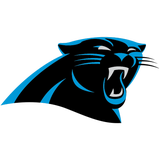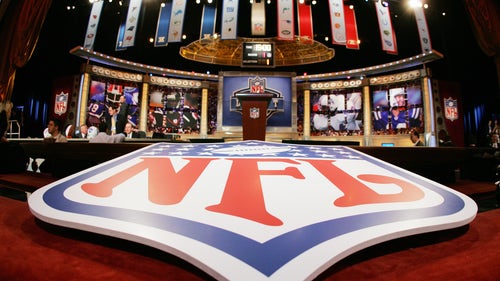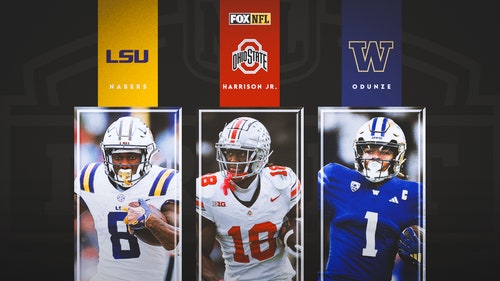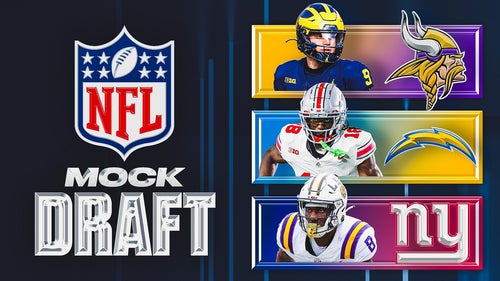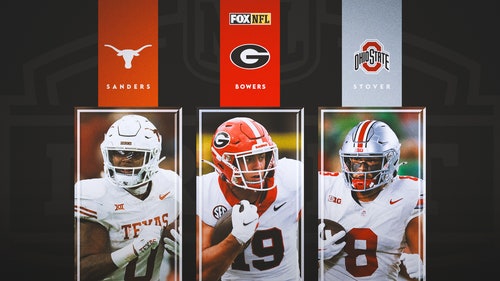
Off-Season Report Cards: NFC South
2016: 11-5, 1st in NFC South. Lost in Super Bowl.
Significant Additions: Offensive coordinator Steve Sarkisian, DT Dontari Poe (FA), DE Jack Crawford (FA), DE Takkarist McKinley (R1), LB Duke Riley (R3)
Significant Losses: Offensive coordinator Kyle Shanahan, DE Dwight Freeney, FB Patrick DiMarco

Let's not harp on the blown Super Bowl lead, and instead remember that the Falcons were an exceptionally good football team in 2016, especially on offense. Atlanta scored 540 points in the regular season—seventh most in league history—as Matt Ryan found his stride, and Tevin Coleman and Devonta Freeman emerged as the NFL's fiercest running back tandem. The good news: Atlanta brings back almost nearly every major player from that offense. (While fullback Patrick DiMarco, who signed a four-year, $8.5 million deal in Buffalo, was popular among fans, the truth is he only played in 31 percent of Atlanta's snaps last season.) This offseason, it's clear GM Thomas Dimitroff didn't want to tinker too much with a good thing; he even re-upped backup QB Matt Schaub for two more years. An extension for Freeman, who is in the final year of his rookie deal, could be on the way.
However the Falcons do lose the man most credit with orchestrating the offense: coordinator Kyle Shanahan, who became the 49ers head coach. How much of the success can be attributed to the play-caller and how much in the talent he's surrounded by? That's not so easy to parse. Atlanta does have an intriguing replacement in Steve Sarkisian, the former Washington and USC coach who spent last year on Alabama's staff. Sarkisian is known in college football circles as an innovative mind, and already Falcons players have noted the coach has added a few new wrinkles to Atlanta's playbook. For now, more details are scarce.
The Falcons did get some help on defense. Atlanta actually ranked 27th in the league in points allowed (25.4 per game). The Falcons should immediately improve with the return of top cornerback Desmond Trufant, who suffered a season-ending pectoral injury in Week 9. Dimitroff has a ton of faith in Trufant and showed it with a five-year contract extension this spring—his $41.5 million guaranteed trails only Joe Haden, Josh Norman and Patrick Peterson.
But more pressing for the Falcons is the front seven. Gone is 37-year-old Dwight Freeney, who had an important role and played very well in the Super Bowl. Dontari Poe, signed on a one-year deal, feels like a quick fix for that. But Atlanta really needs a long-term solution alongside Vic Beasley, so it was important for the Falcons to draft an edge rusher. Quinn is going to take a larger role on defense, and his preference has always been in subbing many players through the front seven. That's why Atlanta traded up to snag UCLA's Takkarist McKinley in the first round. McKinley is a highly emotional player (look no further than draft night) who melds perfectly into Quinn's “brotherhood.” But just as important: McKinley is an ascending talent with tremendous upside as a pass-rusher. In the fall, a scout told me he thought McKinley could be the next DeMarcus Ware.
Overall, it seemed Dimitroff didn't push the panic button after the Super Bowl collapse. He barely touched the offense and made enough tweaks on defense to hope his players can repeat what they did in 2016, with a better finish.
Grade: B
* * *
2016: 6-10, 4th in NFC South.
Significant Additions: LB Julius Peppers (FA), RB Christian McCaffrey (R1), WR Curtis Samuel (R2), OL Taylor Moton (R2), DE Daeshon Hall (R3), CB Corn Elder (R5)
Significant Losses: Defensive coordinator Sean McDermott, Asst. GM Brandon Beane, S Tre Boston, WR Ted Ginn Jr., WR Philly Brown

The 2017 season is all about getting Cam Newton back on track. Over the past three years, Newton's medical history includes ankle surgery, shoulder surgery, a fractured back, cracked ribs, and a concussion. It all seemed to catch up to the Panthers in 2016.
After an MVP season in 2015, in which Newton led Carolina to an NFC championship with a career-high 15 wins, the quarterback's sputtering 2016 was a major league storyline. Newton's 90 carries and 359 rushing yards were his lowest totals since entering the league in 2011 and his completion percentage (52.9) was almost seven points lower than his 2015 mark. Newton was sacked 36 times and underwent surgery on his throwing shoulder in March. Newton suffered the partial tear in his rotator cuff in Week 14, and says he played through it to demonstrate leadership.
Panthers GM Dave Gettleman didn't act as drastically as he did last offseason—read: no Josh Norman-esque drama—but he was active in making life easier for Newton post-surgery, and allowing the offense to evolve. In using its first-round selection on Christian McCaffrey, Carolina not only picked up a running back, but a do-it-all weapon so that Newton doesn't feel he has to make all plays by himself. At Stanford, McCaffrey easily surpassed Barry Sanders' longstanding record for single-season all-purpose yards (McCaffrey totaled 3,864, compared to Sanders' 3,250). Expect McCaffrey to line up in the backfield, in the slot or out wide, take traditional handoffs between tackles, or handoffs around the edge and return punts or kicks.
Versatility and speed were major points of emphasis on offense, especially after Carolina let its fastest player, wideout Ted Ginn Jr., walk in free agency—to the division rival Saints, nonetheless. The Panthers used a second-round pick on Ohio State's Curtis Samuel who, like McCaffrey, has the potential to line up all over the offense (and his speed is no joke: a 4.31 in the 40 at the combine). Both players are explosive, with tremendous yard after catch potential, which figures to add a few more wrinkles to offensive coordinator Mike Shula's game plan. More importantly, it can give Newton more high-percentage throw opportunities. Newton completed only 44 passes to his backs last year. That's something Shula noted in his conversation with The MMQB's Peter King after the draft. As Shula told King: “In the Super Bowl, how many passes do you think Tom Brady threw to his backs? Mostly completed, right? So maybe, sometimes, it turns into just a 4-yard gain. But I'll take a 4-yard gain. ... They're glorified runs sometimes, but they work and it doesn't matter what you call them.”
Newton has never had a season where he was sacked less than 33 times. In an effort to limit, the Panthers might lessen the design QB runs in their offense. They also worked on beefing up the offensive line with another second-round pick, Western Michigan offensive lineman Taylor Moton. The 6-foot-5, 319-pound lineman can play right tackle or guard, but his physical and athletic traits should benefit Newton in 2017 and beyond.
The Panthers didn't tinker a ton on defense this offseason, but the moves they made sure are interesting. Carolina has arguably the top linebacking corps in football, but added two pass-rushers who could help generate more pressure. In free agency, the Panthers added 37-year-old Julius Peppers. It's more than just a trip down memory lane; Peppers tallied 7.5 sacks for the Packers last year while playing less than 60 percent of the team's defensive snaps. Carolina also traded up in the third round for Texas A&M's Daeshon Hall, who may need some development. He's still learning the nuances of defensive end after beginning his career as a linebacker, but has tremendous potential in getting after quarterbacks.
Grade: B
* * *
2016: 7-9, 3rd in NFC South.
Significant Additions: WR Ted Ginn Jr. (FA), G Larry Warford (FA), LB A.J. Klein (FA), LB Manti Te'o (FA), QB Chase Daniel (FA), CB Marshon Lattimore (R1), OT Ryan Ramczyk (R1), S Marcus Williams (R2), RB Alvin Kamara (R3), LB Alex Anzalone (R3), DE Trey Hendrickson (R3)
Significant Losses: WR Brandin Cooks, S Jairus Byrd, OL Tim Lelito, DL John Jenks, RB Tim Hightower, RB Adrian Peterson

The Saints haven't made the playoffs for three straight years, and you can sense some urgency to squeeze one more run out of 38-year-old quarterback Drew Brees. New Orleans was very active this offseason and although much attention will be paid to the late addition of Adrian Peterson (more on that later) it's clear the front office is aware of its biggest hurdle: a leaky defense.
New Orleans' three biggest area of needs heading into the offseason? The secondary, the pass rush, and depth at linebacker. The Saints first addressed linebacker in free agency. New Orleans recently has relied on a rotating cast of versatile linebackers and 2017 should be no different. Entering the mix is A.J. Klein, the 25-year-old who comes from the division rival Panthers. The Saints paid Klein starter's money (three years, $15 million) meaning he should be manning the middle. New Orleans also added Manti Te'o at a bit of a bargain (two years, $5 million). Should Te'o's health hold up — he missed 13 games in his first three seasons because of foot or ankle injuries — the 26-year-old could surprise. And in the draft's third round, New Orleans added Florida linebacker Alex Anzalone. He, too, faces durability questions, but he has excellent size and athleticism and experience playing in all three linebacker spots.
That Ohio State cornerback Marshon Lattimore was available at No. 11 was a blessing for New Orleans, in desperate need of a lockdown corner. A deal for Malcolm Butler never came to fruition, but that's fine because Lattimore's ball skills (four interceptions and nine pass breakups in his lone year as a starter) are elite. In a historically deep year for cornerbacks, Lattimore was the top-rated on most team's boards. Marcus Williams from Utah is a ball-hawking free safety who, paired with Lattimore, will give the league's worst ranked pass defense (274 yards allowed per game in 2016) an immediate boost.
Fans will gripe that New Orleans only answered to two of its three defensive needs. The Saints were unsuccessful in finding a pass-rushing talent to relieve some pressure from Cam Jordan. UCLA's Takkarist McKinley would have been a great fit, but the division-rival Falcons swooped ahead to draft him. With New Orleans' top pass-rushing targets (Taco Charlton, Charles Harris and McKinley) gone at No. 32, the Saints used the pick they got from trading Brandin Cooks for future offensive line assurance in Wisconsin's Ryan Ramczyk. Adding who many considered to be the draft's top offensive tackle isn't a bad choice, but it's fair to wonder if not addressing the pass-rush will ultimately doom this team.
The loss of Cooks shouldn't be too much of a blow for Brees. Free agent addition Ted Ginn Jr. is a lesser version of Cooks, but Brees will likely pay more attention to emerging star Michael Thomas and Willie Snead. (Don't totally sleep on undrafted free agent Travin Dural of LSU, although his immediate impact might be on special teams). And of course, there is Peterson. The 32-year-old is thirsty for redemption and might just find it in a downhill run game reminiscent of what he was used to in Minnesota. Third-round draft choice Alvin Kamara may seem like a luxury pick (especially with Mark Ingram coming off a 1,000 yard season) but like the Ramczyk selection, the Saints are preparing for life beyond 2017 as well.
Grade: B-
* * *
2016: 9-7, 2nd in NFC South.
Significant Additions: WR DeSean Jackson (FA) TE OJ Howard (R1), S Justin Evans (R2), WR Chris Godwin (R3), RB Jeremy McNichols (R5).
Significant Losses: QB Mike Glennon

GM Jason Licht had a clear offseason directive: give Jameis Winston as many weapons as possible. Winston is only 23, with two 4,000-yard seasons. However the Bucs are wary of the quarterback's turnover problem. Winston threw 18 interceptions in 2016, with 10 fumbles (six lost). Many times, it feels like Winston tries to do too much himself. To remedy that, Licht surrounded Winston with playmakers who can relieve some of that pressure.
It began in free agency with wideout DeSean Jackson (three years, $35 million). The 30-year-old speedster has built a reputation over nine seasons as the best friend to a quarterback. Paired with budding superstar Mike Evans (three straight 1,000 yard seasons) and the Bucs may have the best 1-2 receiver punch in the league. Actually make that 1-2-3, as Tampa Bay found a gem in the third round by drafting Penn State's Chris Godwin. Most evaluators pegged Godwin as a second-round talent. The 6-foot-1, 209-pound Godwin is deceptively fast, averaged 16.6 yards per catch last year while possessing many of the same traits (separation on routes, ability to win contested catches) that made his Nittany Lion predecessor, Allen Robinson, successful in Jacksonville.
And all of this doesn't factor in perhaps the Buccaneers' biggest coup: snagging Alabama tight end OJ Howard in the first round. In a historically rich year for tight ends, it says something that Howard was unanimously atop of the class. At 6-foot-6, 251 pounds, scouts rave about Howard's long arms and athleticism. Evaluators say his so-so production at Alabama was a byproduct of being underutilized as a pass catcher. Cameron Brate emerged as a revelation for the Buccaneers in 2016; the Harvard alum had eight touchdowns, and was especially dangerous in the red zone. Add Howard to the mix and Winston is covered with two tight ends who can in-line block and stretch the field. The question now is: can Winston keep all of his targets happy? Of the quarterback's franchise-record 28 touchdowns in 2016, he threw nearly half (12) to Evans and another eight to Brate. He has a few more mouths to feed in 2017.
The running game figures to be interesting, as well. Incumbent Doug Martin struggled last season (2.9 yards per carry) and left the team with one game remaining to serve a four-game PED suspension and check into a drug treatment facility. That suspension will spill into 2017, but one of the reasons the Buccaneers didn't draft a running back in the first round—Winston's former Florida State teammate, Dalvin Cook, was a potential match—was that the front office apparently feels comfortable with the strides Martin has made this offseason. Martin, of course, had an outstanding rookie season in 2012 with 1,454 yards and 11 touchdowns. He's only matched that production once, in 2015. If Martin can't find his groove, Tampa Bay found a worthy replacement in fifth-rounder Jeremy McNichols from Boise State. It seems important to note that McNichols and Martin have nearly identical statures (5-foot-9 and stocky) and skill sets. Licht has praised McNichols as the best pass-protecting running back in the draft, and like Martin, he adds value as a pass-catcher. In fact, McNichols was a wideout in high school. Perhaps Tampa Bay will find a role for both of its running backs, two more weapons to add to Winston's arsenal.
Grade: B+
• Question or comment? Email us at talkback@themmqb.com.
